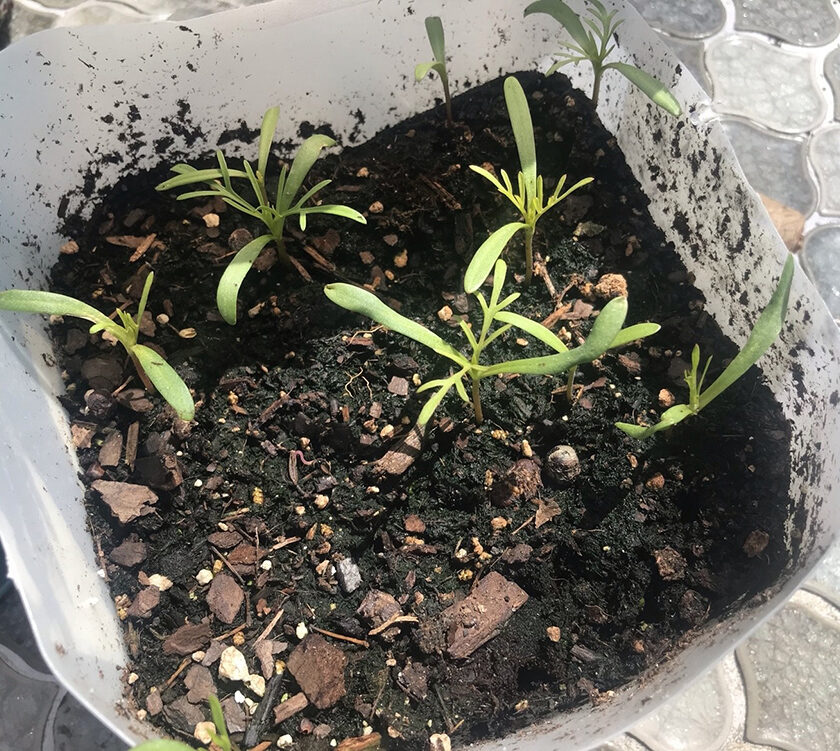Let It Grow
By Tammy Thornton
If you haven’t jumped on the Winter Sowers bandwagon, it’s time to hop aboard! Winter sowing is a method of seed germination that allows gardeners to plant seeds outdoors in the winter months. Seeds are subjected to freezes and thaws, encouraging them to break dormancy and germinate in a natural way. Small plastic containers serve as mini greenhouses, protecting the seeds until they germinate.
Winter sowing was developed by Trudi Greissle Davidoff around 2003. Her method was widely popularized through the Facebook group “Winter Sowers”, currently boasting over 100,000 followers. While planting seeds outdoors in winter sounds counterintuitive, this method of propagating plants takes advantage of the freezing and thawing of winter weather to naturally break down seeds’ outer shells and wake them up from dormancy. These seeds then naturally germinate at just the right time, producing tough little seedlings that don’t need to be hardened off. Winter sowing also eliminates the need for grow lights and space indoors.

Traditionally, winter sowers use cleaned, recycled, gallon-sized milk jugs to plant their seeds. The milk jugs or other containers act as mini-greenhouses, giving them a small level of protection from harsh weather as well as from little critters. The lids of the milk jugs are removed and holes are made in the tops and bottoms of the containers. The openings in the top allow small amounts of rainwater and snow into the jug and also provide ventilation, while the bottom holes give the containers the required drainage. You can get creative by using different types of containers such as clear clamshell plastic (like the kind a rotisserie chicken would come in) or other types of clear plastic containers with lids. When using milk jugs, cut the jug in half horizontally, leaving a hinge at the handle. Fill the bottom of the jug with approximately three inches of potting soil. Water the soil thoroughly and allow it to drain. Plant seeds the depth suggested on the seed packet. Then carefully water, being sure not to displace the seeds.
Once your seeds are planted, you will want to label them to avoid a frustrating guessing game in the spring. Use a weather-proof marker or pen on a popsicle stick placed inside your container. Then close and reseal the milk jug with duct tape. At the proper time, as temperatures warm, you will see your little seedlings begin to sprout. Keep in mind that the seeds of different plants will germinate at various times. It will take a bit of patience. Don’t give up if you don’t see the baby green leaves for a while. Rain or snow should sufficiently water the seeds, but check your containers once in a while to make sure they don’t thoroughly dry out. You may need to add a small sprinkling of water if we haven’t received much rain.
As spring nears, and days become warmer, open the containers and allow your seedlings to breathe in the great outdoors. Reseal during cold nights. When the danger of frost is over, you can transplant your seedlings into their permanent home in your garden. The beauty of winter sowing is that you don’t need to harden off the seedlings like you do for plants that were germinated and coddled indoors. Winter sown seedlings will be tough babies that will laugh at the cold.
Once you see the success rate of winter sowing, you’ll be smitten. You may find yourself drinking more milk and eating more spinach just to get your hands on more containers. This method works for perennials, annuals, vegetables, herbs, and flowers. You can find more detailed information on the Winter Sowers group Facebook page. You can also send your questions and comments to: shorelocalgardener@gmail.com.
Tammy Thornton is a mom of four, a substitute teacher, and a Sunday school teacher. She is passionate about gardening and cooking, and loves the beach.






